
Nintendo has not been accustomed to failure over the past few decades, so it was a surprise to many to learn that the Kyoto-based giant is embracing one of its most costly failures: the Virtual Boy.
Reading the recent news story on the value of Athena's Virtual Bowling, in relation to Nintendo's surprising Virtual Boy announcement, I messaged Time Extension editor Damien McFerran about the fact that Volume 3 of The Untold History of Japanese Game Developers had an interview with Aziz Hinoshita.
He'd worked at Athena, and described Virtual Boys lying around the office, chain-smoking at one's desk, and getting seriously wired on energy drinks. It might make a fun update to the story, describing the company which published Virtual Bowling, plus there was a funny comic to go alongside.
Discussing the idea, it dawned on me that the books actually contain a lot of material: across Volumes 2 and 3, the words "Virtual Boy" are mentioned a whopping 56 times – not bad for a console that is considered one of Nintendo's biggest flops.
Henk Rogers weighed in on the fact there were two versions of Tetris for the system, there was a detailed account of an unreleased Space Harrier clone at Human Entertainment, plus of course the making of Red Alarm, among other anecdotes.
So without further ado, let's read through some of the recollections.
Aziz Hinoshita, Athena
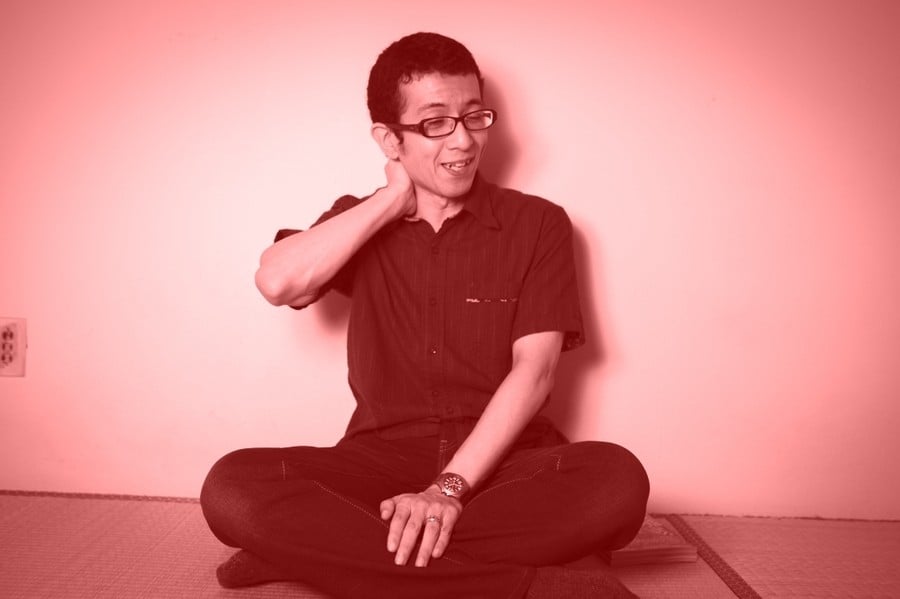
Although best known for his localisation work at Square-Enix, Aziz Hinoshita in fact started his career at Athena. While he never actually worked on Virtual Bowling, he did localise Athena's Super Bowling for N64, offering insight into why the company liked the sport.
If you look at Athena's portfolio, it was credited with at least seven bowling games! Virtual Bowling's development is attributed to Tose, with Athena as the publisher, but according to Hinoshita, the company was clearly hands-on with the system. He gave a hilarious description of the work environment and getting a serious buzz during crunch, also drawing an office map showing the Virtual Boy junkyard and little ashtrays everyone had.
"Most title ideas came from up top, and they'd just get made. [The CEO was not hands on.] He would meet with the producers, but most of the time he would be in the CEO room and be sleeping on the couch, or smoking. <laughs>
It was fun at first. But we'd go through one project, and it became less fun, and it became 'work' obviously. Since we were just working on titles that the CEO would tell us to work on. Super Bowling [for N64] was developed internally by Athena. They wanted to release that in the US, because 'bowling is big in the US!' Apparently. <laughs> Some marketing results and all that.
The office plan was actually pretty open. We had one or two programmers per team, and one planner or game designer, and one or two artists. So they were really small teams. Five or six people back then. There was a lot of junk in the office. Like old hardware. There was a little table near the windows, where nobody was sitting, and there were all these old monitors, keyboards, and a bunch of boxes with stuff, things I'd not seen before, as well as Virtual Boy units. Yeah, they had them lying around."

"We had the whole floor of a building, but it was a really small building. We had punch cards! There were also bunk beds, with mattresses that probably weren't cleaned for a year or so. They were kind of itchy! Those were the things we had to rest on, during crunch time. Otherwise we would just sleep under our desks and stuff. Everyone smoking at the same time.
We would sleep over for a couple of days, and then go home and take a shower, come back, in the morning. And the head producer would buy these super hardcore energy drinks, with like - I dunno - 200mg of caffeine, so we could just stay up all night and work all night. Those are not very good for extended periods of time, because it makes you paranoid. Seriously, yeah!
Myself and the planner I was working with, were kind of getting, you know... <wide eyed face> We weren't getting any visions or anything, but we were getting close to that near the end."
Tokihiro Naito, T&E Soft
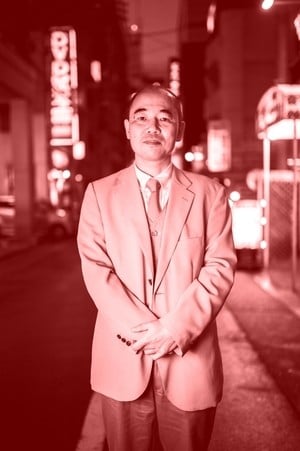
As the creator of Hydlide, one of Japan's earliest RPGs and one of the best-selling at the time, Tokihiro Naito is an important developer. In later years, though, he shifted to a managerial role at T&E Soft, where he witnessed the development of Virtual Boy titles.
"As a general manager, I did see work going on for that system. People would spend hours doing debugging work with the Virtual Boy pressed against their face, and when they finally pulled away, there would be black marks on their face from the headset. I know Red Alarm; it was created by the Osaka office of T&E Soft."
Naito also described the challenging work conditions at T&E, explaining the company's notorious hamachi room:
"That's where we hid all the prototype hardware we received from manufacturers for testing. When you entered the room the door was locked from the outside. Sometimes we'd throw a programmer in there, lock the door, and say, 'We'll let you out once you finish your code!' <laughs> It's the room where people went to work during crunch time, so it's 'crunch' (kaihatsu ni HAMAtta) plus 'people' (hitotaCHI), which is shortened to the 'hamachi room', or crunch room. Another theory was that the people who got tired and were found rolling around in their sleep on the floor looked like freshly caught hamachi, a type of fish. <laughs>"
So if you ever feel any physical discomfort while playing the Virtual Boy, please know that the developers also felt discomfort when making the games.
Mitsuto Nagashima, T&E Soft
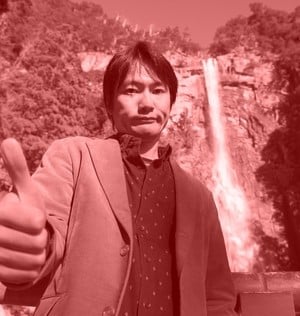
We've already run a lengthy Making Of feature for Red Alarm, one of the system's best games. But let's recap just a couple of Mitsuto Nagashima's answers.
"At that time, there seemed to be a lot of enthusiasm for developing three-dimensional shooting games. T&E vice president Eiji Yokoyama went to Nintendo to see the technology, and came back saying, 'We could probably do a wireframe 3D shooter.' When president Toshiro Yokoyama heard that, he apparently gave it a green light on the spot. That sort of decisiveness was one of the things I admired most about T&E Soft.
The first Virtual Boy I ever saw looked like a handmade black box with two square eyeholes cut into it. When I looked through the holes, everything was red. I remember seeing a demo of a polygonal bird flying around. When I asked the developer why it appeared to be in three dimensions, he explained that there was a different screen for each eye so that they could project a different image to each.
Afterwards, we talked with the lead developer who made a passionate case for the Virtual Boy, saying things like, 'A game doesn't need colour to be interesting,' and '3D will open up all sorts of new possibilities!' After learning all there was to know about the Virtual Boy, Nakatsuji-san and I got into a taxi and headed back to the office.
As we rode, I heard Nakatsuji-san mutter, 'So that's Gunpei Yokoi...'
Me: 'What?'
My Boss: 'He's the man who invented the Game & Watch!'
Me: 'Whaaaaaaaat?!'This was the pre-internet age, so there wasn't really any way to find out who had made the things that I had loved so much as a kid. So it was only then that I realised what an incredible person I'd be working with on this project.
When I got back to the office, I immersed myself in trying to imagine what sort of red shooting-game screen wouldn't disappoint Yokoi-san. I was in charge of the game's content, balance, enemy positions, and even parts of the story."
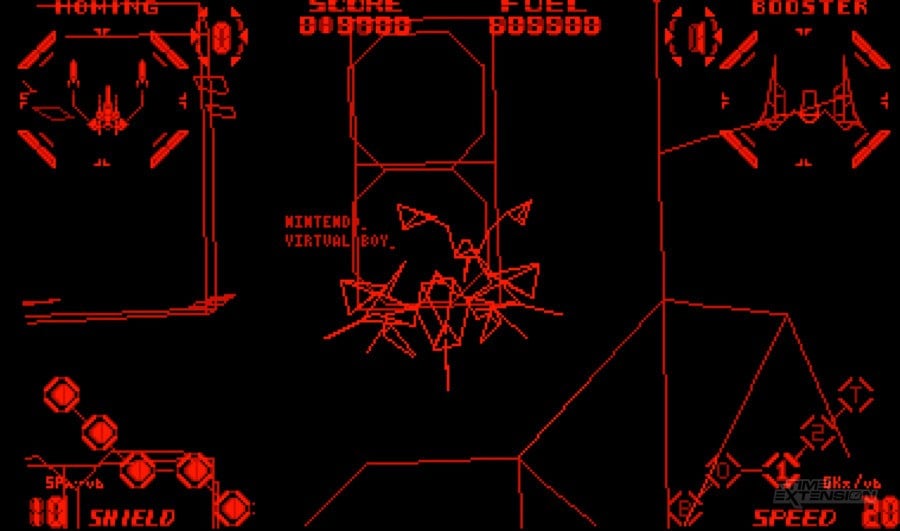
Nagashima also worked on 3D Tetris for the system. It came out March 1996 in America; although a Japanese version was planned (Polygo Block), it was never actually released in Japan. Nagashima gave a detailed account:
"After completing Red Alarm we moved straight into development of 3D Tetris. Making the game in 3D required starting from scratch on the Virtual Boy. The game was designed by Kono-san.
He'd tell us he had a good idea, we'd implement it and see how it worked, and then he'd tell us he had another good idea, and we'd implement that. It was a continuous process of trial and error. Even within the development staff, there was a lot of trial and error in trying to make the polygons easier to see in 3D and to improve the game's refresh rate.
I was in charge of the polygon display and the completion animations in puzzle mode. I was able to use the same basic wireframe techniques that I used in Red Alarm to make the polygons. As for the animations, the puzzles transformed into various shapes, like an F1 Racer, a dog, or a statue when the puzzles were finished. I had to painstakingly program in each of those sequences one by one.
The puzzles were intended to serve as little breathers between stages, so there were originally only going to be five of them."
The Puzzle Mode he describes was an ingenious twist on the traditional formula of Tetris, but it's difficult to convey in screenshots. Basically, you're shown a 3D object at the bottom of a well, built out of blocks, and must replicate it using the pre-chosen blocks which fall down the well. What makes it tricky is that some blocks overlap, and specific shapes can be achieved in different ways. After completing the construction correctly, it morphs into a cuboid version of what it represents. For example, a Sea Lion that looks like it's made of Lego.
Nagashima then explained how this "breather" was spun off into its own unique game mode:
"Since they were blocks, there was a limit to the amount they could animate, and I had to come up with a lot of tricks. Early on, I tried to do unique things like having the F-1 Racer's tires spin around. When Yokoi-san saw that, he burst out laughing, saying, 'Look at those square tires spin!'
Maybe because those sorts of things were well received, the puzzles became their own mode and the number of stages increased to 20. It was hard thinking of 20 stages worth of character animations, and when I look at what I came up with, a lot of them barely make any sense to me now."
The strange thing is that 3D Tetris, despite being developed in Japan, was only released in America. I pressed Nagashima on why, and also if he was involved in T&E Soft's Virtual Golf title:
"Around that time, apparently our president Yokoyama was contacted by the president of BPS, who said, 'For some reason Nintendo won't give us permission to release Tetris on the Virtual Boy.' And apparently instead of Yokoyama-san saying, 'That's because we're working with Nintendo on a 3D Tetris game,' he just said 'hmmm,' and changed the subject.
I don't know why 3D Tetris was never released in Japan, although I may have known back then and just forgotten. It was probably some boring business reason, like the Virtual Boy's declining sales, or a rights issue.
The developers of Virtual Golf and I exchanged information about the Virtual Boy, but I wasn't directly involved with its development. After completing Red Alarm and 3D Tetris we ceased further development due to the Virtual Boy's sluggish sales. Personally, I had wanted to make a racing game next."
Henk Rogers, Bullet Proof Software

There were two Tetris titles for the Virtual Boy, which only saw 22 official retail releases. Meaning that nearly 10% of the entire system's library was just Tetris!
When interviewing Henk Rogers, given he's asked about the series so often, I wanted to avoid any Tetris questions to focus on his foundational RPG, The Black Onyx, and creating the only game Hiroshi Yamauchi ever played.
However, I did ask one: if BPS published V-Tetris for Virtual Boy, while 3D Tetris was developed by T&E Soft, presumably T&E had to acquire the license from BPS. Weren't they thus facilitating a rival?
Rogers was frank in his reply: "Nah. I mean, Virtual Boy was dead on arrival. We sold more copies of Tetris for Virtual Boy than Nintendo sold of the Virtual Boy! <everyone laughs>"
Given his friendship with Hiroshi Yamauchi, I then asked if the topic of the Virtual Boy ever came up during conversations.
"No! That's a... That's... Nooo, absolutely not! I don't know, well, I may have, but... I never pulled punches, I always told it like it was, and that's why he liked me. So we may have discussed it, but..."

I suggested perhaps it was a taboo subject?
"<incredulous> Yeaaah! Yeah! And Yokoi left the company as a result. I mean that guy made Nintendo's game business, for chrissakes! He invented all that stuff. I take my hat off to that guy. And then to leave the company because of... Virtual Boy? Hey, he's not the only one that's responsible for that product. Anyway, but that's the way Nintendo is. Or that's the way Japanese companies are. Somebody has to take responsibility."
While the story of Gunpei Yokoi leaving Nintendo as a result of the Virtual Boy's failure is a well told story, in recent years it's been debunked somewhat, with the They Create Worlds podcast pointing out that Yokoi worked on the phenomenally successful Game Boy Pocket after the Virtual Boy.
Given Nintendo's recent warming to the hardware and its library, hopefully, further first-hand accounts will surface.
Kenichi Yokoh, Raizing

The account of Kenichi Yokoh raises an interesting anomaly. He's primarily credited on shooters by Raizing / Eighting, and yet he was also credited as the game and graphics designer on Panic Bomber.
The Super Famicom version is attributed to Raizing, so that makes sense, but the Virtual Boy version's development is attributed solely to Hudson. Yet Yokoh is still credited. I'm unsure if he personally sat down to work on the Virtual Boy's graphics, or if his SFC graphics were simply converted, but he stopped partway to take over Soukyuugurentai. So his anecdote isn't massively about the Virtual Boy itself, but we'll use any excuse for fun trivia!
"I had actually been working on a different project, Panic Bomber, but I had heard that after a year in development Soukyuugurentai still wasn't coming together, and the company had lost faith in the title.
We were trying to make a vertical scrolling game which was enjoyable on a horizontal screen - for playing both at an arcade and at home. The main designer, Kazuyuki Nakashima, came to me and asked me to manage the project and usher it to completion, otherwise it would never get published. Even after a year of development I felt I needed to make a number of significant changes, adding in the human characters, changing the game mechanics, and redoing the stage layouts. [...]
Shooting games have very simple rules. So I wanted to distinguish the games with enjoyable mechanics as well as engaging characters. Scrolling shooters, in particular, provide a sense that the player is on a journey, with the stages unfurling like a scroll.* So with the stage design, I want to provide a sense that the player has travelled a great distance through exotic locations."
(* Yokoh said makimono (巻物), literally a scroll, so imagine one of those ornate Japanese art scrolls; it was a very poetic way of describing 2D shmups!)
Takashi Takebe, Hudson

Joining Hudson around 1980, Takashi Takebe would see the company's rise as a computer developer, visiting London to make business deals regarding the ZX Spectrum, later producing Family BASIC for Nintendo's Famicom, and overseeing the development of Super Mario Bros. for the NEC PC-88 computer. He's had a diverse and fascinating career!
He also witnessed Hudson's development of Virtual Boy games. The company took the hardware seriously, with a Bonk game even being considered at one point, plus the aforementioned Panic Bomber. Takebe was only credited on Vertical Force, so I asked what he recalled.
"That was the Virtual Boy game, right? We had multiple teams creating numerous titles simultaneously. Despite being only red, the Virtual Boy had LEDs that allowed it to display very clear images. We may have liquid crystal displays now, but I still think the Virtual Boy was probably just too ahead of its time. [...]
Masaki Higuchi & Hifumi Kouno, Human Entertainment
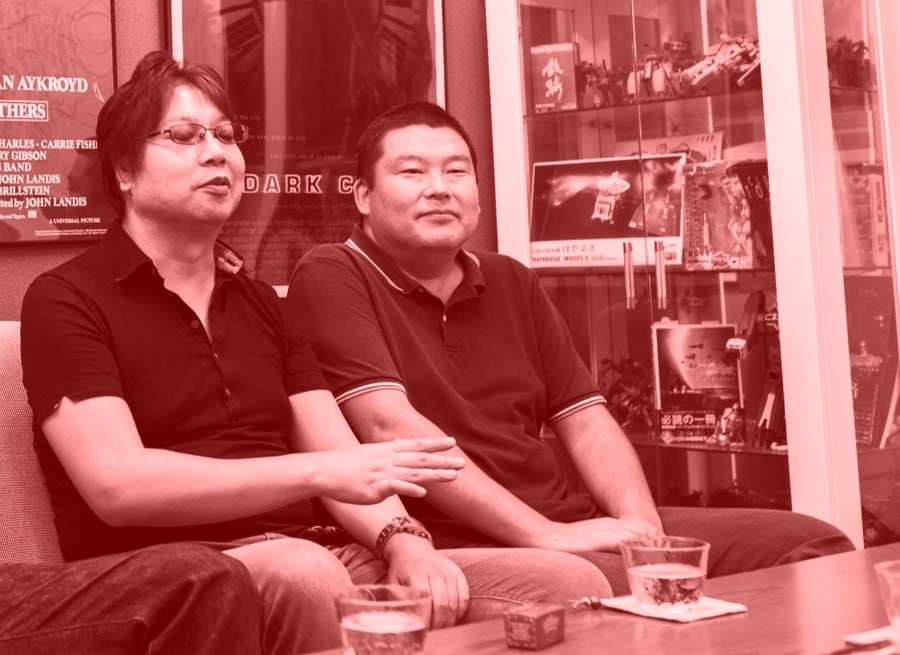
Given the hardware's short lifespan, it's unsurprising to find anecdotes about unreleased games, such as Hudson's Genjin Show ~Tobidase! VB Genjin~. Developers most likely started work, hoping the hardware would be a success, and then would have abandoned projects when the system died out.
One of the more interesting unreleased titles was a Space Harrier clone by Human Entertainment. This anecdote was shared by programmer Masaki Higuchi (Clock Tower 2) and designer Hifumi Kouno (Steel Battalion), during an intense roundtable discussion between them and another Human alumni.
Specifically, Kouno references Tomonori Koike as being behind the unreleased Virtual Boy title; I never interviewed him, but it's a good lead for others to follow. Might we see this intriguing game brought to light some day?
Higuchi: For the first year or so after being hired, I was a sub-programmer on about three titles. After that, new systems such as the PlayStation and the Virtual Boy started appearing, and my boss told me I had to work on the Virtual Boy next. I was totally opposed to the decision, because I really wanted to work on something for the PlayStation. I told my boss that I refused to work on the Virtual Boy. I was half-expecting to get fired. But luckily, people were starting to talk about porting Clock Tower to the PlayStation, and ultimately it was decided to do a proper sequel. So my first major project was as the main programmer for Clock Tower. This was also the first time I worked with Kouno-san. I only made some development tools for the Virtual Boy. I didn't think the system was going to sell well. <laughs> My boss at the time was a huge Nintendo fan, so he kept pushing us towards the Virtual Boy. But I knew the PlayStation was much better.
Kouno: So the only unreleased games I know about are Geo Catastrophe [for Super Famicom], and a Virtual Boy game that [Tomonori] Koike-san was working on. For the Virtual Boy game, the reason it wasn't released was because, well, it was the Virtual Boy. The Virtual Boy system was a failure, and although someone created a game as an experiment, the company decided against releasing it. On the other hand, the cancellation of Geo Catastrophe was a bit of a shame. The Virtual Boy game was boring, a cheap Mario knockoff.
Higuchi: Was it? Wasn't it a 3D game like Space Harrier?
Kouno: Oh, that's right, sorry. It was a cheap Space Harrier knockoff!
Higuchi: There was a sense of depth, in 3D, like Space Harrier.
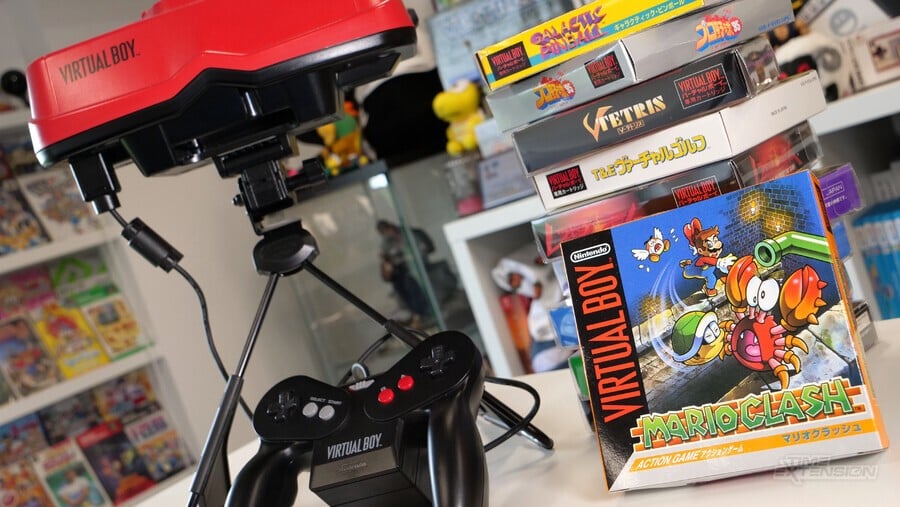
Kouno: 3D? <with mock enthusiasm> "Space Parrier!" <everyone laughs> They [the games] must have been thrown out.
Higuchi: It must have been saved in some way though, right?
Kouno: Maybe, but they're surely gone by now.
Higuchi: As I said, I just created some tools in the beginning, and because I thought the Virtual Boy wasn't going to sell, I told my boss I wanted to work on the PlayStation. So I wasn't involved. <laughs>
Kouno: You deserted your post!
Higuchi: Yes, I'm a deserter. <laughs>
Szczepaniak: Did Human complete any Virtual Boy games, or did they only work on that unreleased one?
Higuchi: That was probably the only one.
Kouno: It may have been a requirement imposed by Nintendo. To develop games for the Nintendo 64, Human also had to develop something for the Virtual Boy.
Finally, a word from your author:
A few years ago, I decided to invest in a Virtual Boy system, ordering one from Japan. HMRC burned me with import taxes, and then the system didn't even work, with the LED ribbon cable coming loose. It cost £40 to repair, on top of the £320 for the unit itself. Then came the games...
There's been some weird push-back in recent years regarding the headaches and other physical discomforts of the system, suggesting they were urban myths. Please let me reassure you that the pain is very real. It is almost impossible to find a comfortable position for playing. The only urban myth, in my opinion, is that people can play it lying on their back, with the unit resting on their face. Have you ever held a Virtual Boy? That thing is heavy and extremely painful to have sitting on your face for several hours. This isn't like the Lady Godiva Position (do not Google that). No, using the official stand is the only way to play.
For a tall person with long arms, such as myself, the controller cable is so short you're forced to bend your elbows and hold the controller to your chest, causing muscle cramp. It causes neck pain, shoulder pain, spinal pain, muscle fatigue, numbness in the arms, headaches, migraines, eye strain, blurred vision, disorientation, and dizziness after prolonged play.
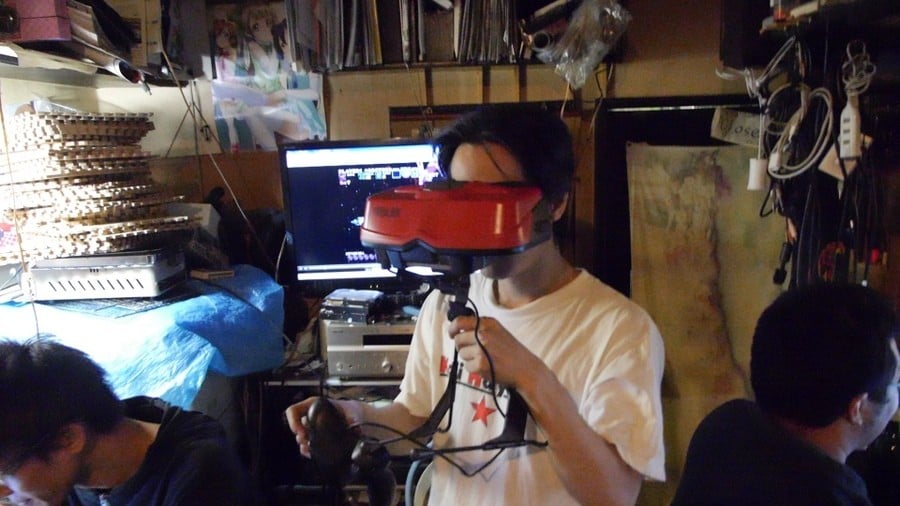
Disturbingly, in my case, after a marathon 2-hour session, I developed temporary partial colour blindness. Red objects appeared grey - in fact, I first noticed this because the LEDs in the headset started appearing greyish-white during a high-score run of Waterworld. The game allows something ridiculous, like up to nine players, and is a bit like Defender, albeit in 3D, so I was trying to get a really high score over a long period. When I stepped away from the machine, everything normally coloured white, such as painted walls, had a weird blue tint to it. I'm not a doctor, but I'm guessing the light-sensitive red cones in my eyes had been desensitised due to being blasted with high-contrast red light for several hours, and only the yellow and blue were functioning.
For the record, I did not take the recommended breaks every 15 minutes; I simply sat there for over 120 minutes, pausing only to swap game cartridges. I do not recommend this, and after the colour blindness, I was freaked out enough to start heeding the health warnings.
Despite how awfully designed the system is, and the very real physical agony it causes, I actually really like the Virtual Boy (or perhaps I just have Stockholm Syndrome). It's not so much a virtual reality headset as it is a 3D viewing box, displaying games as a sort of diorama. The fishing game for example is quite relaxing, and the stages look like little stage theatres with cardboard scenery. It's adorable.
Of the released 22 games, there are several which are a lot of fun. From those officially announced, I highly recommend: Insmouse No Yakata, Jack Bros., Red Alarm, Wario Land, Vertical Force, and 3D Tetris. Mario Clash is also alright, in short bursts.
However, if I can make one plea to the powers that make such decisions: please find who owns the rights to Bound High! and release the finished prototype. No other game in the library showcases the potential of the Virtual Boy like Bound High! does.
The perspective, the use of 3D, the pure and simple fun of it. The game has been leaked online, and those with a flashcart can enjoy it, but given that the game was actually completed, it really deserves a proper chance at retail. Development is attributed to Japan System Supply, and Nintendo was meant to publish it. If by some miracle, somehow, it ends up getting an official release, then it receives my highest recommendation possible. it's my favourite game on the system.
John Szczepaniak is the world's leading English language expert on the history of Japanese video games, occasionally lecturing on the subject. He's been a journalist for 20 years and has written for more than 20 publications, including Retro Gamer, GamesTM, Official PSM, Game Developer, and Gamasutra. He is the author of The Untold History of Japanese Game Developers series of books and Japansoft: An Oral History, while contributing to others.
